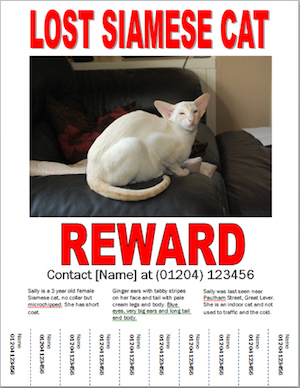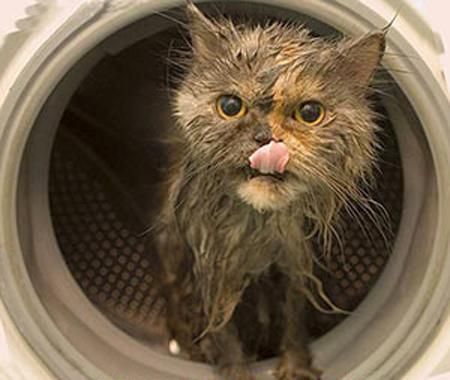Jamie Farr, M*A*S*H Corporal Klinger
 The craziest sane man to ever enlist in the 4077 (M*A*S*H) is Jamie Farr, better known as Corporal Maxwell Q. Klinger. Jamie Farr started his career cleaning the cages of chinchillas. Animals have always been a part of his life and he's proud to share his story.
The craziest sane man to ever enlist in the 4077 (M*A*S*H) is Jamie Farr, better known as Corporal Maxwell Q. Klinger. Jamie Farr started his career cleaning the cages of chinchillas. Animals have always been a part of his life and he's proud to share his story.
In the beginning of Jamie's career when he was studying theater, roles were infrequent for the young actor, and he took jobs as a delivery person, a post office clerk, an army surplus store clerk and an airlines reservations agent.
Jamie also states, "I had to take a job in a Chinchilla Ranch where I had to clean out the dropping pans." He says, "I was really raking it in then!" But, he wasn't the only one in acting class doing these odd jobs. He mentions that, "Clint Eastwood was cleaning out swimming pools."
When Jamie was originally hired for M*A*S*H, it was for one episode. He wasn't part of the original cast, but states, "I was a tack on. I was a one-day day player. I came on and I think I got $250 for the day. I had four lines one the show." The next thing he knew, they kept calling him back. He did about 6 shows the first year, 12 shows the second year, and then in the third year they signed him to a contract.
Jamie's character on the show was Corporal Maxwell Q. Klinger a cross-dresser who wore his infamous Fuzzy Pink Slippers, in the hopes of getting out of the Army.
Hal Abrams stated, "I always thought you were the most sane person on that show!" To which Jamie replied, "You have a warped way of looking at the world I'm afraid Hal!"
Jamie and his wife, Joy, are currently owned by 3 cats. Jamie states that his wife is the "Pied Piper." If there is an animal out there, they will go to her. She is the kindest, sweetest, thing that you have ever imagined in your life. He mentions that they have always had pets and he couldn't think of one time when they didn't have animals in the house.
Together they wrote a children's book, Hababy's Christmas Eve, the story of a camel family that Jamie first introduced on M*A*S*H.
What Are The Chances Your Pet Will Ever Be Lost or Found?
Dr. Emily Weiss, ASPCA
 The ASPCA (The American Society for the Prevention of Cruelty to Animals) conducted a telephone survey of more than 1,000 pet-owning households across the country and uncovered new data regarding how many pets have been lost, how many ultimately made it home, and how their guardians found them.
The ASPCA (The American Society for the Prevention of Cruelty to Animals) conducted a telephone survey of more than 1,000 pet-owning households across the country and uncovered new data regarding how many pets have been lost, how many ultimately made it home, and how their guardians found them.
The study involved a random digit dial survey of pet guardians to find out if they lost a dog or cat in the past five years - and if they did, did they find that pet - and where did they look? There were 1,015 households that had cared for a dog or cat within the past five years, and of those pet guardians surveyed:
- 15 percent had lost a dog or a cat in the past five years - a lower number than had been anecdotally reported
- 85 percent of those lost dogs and cats were recovered
- The percentage of lost dogs compared to lost cats was quite similar - 14 percent for dogs and 15 percent for cats
- Cat guardians were less likely to find their cat - only 74 percent of lost cats were recovered, while 93 percent of lost dogs were recovered
 More dogs were found because of the differences in the way people treat dogs and cats. As an example, cats are less likely to be wearing a collar and tag than dogs are.
More dogs were found because of the differences in the way people treat dogs and cats. As an example, cats are less likely to be wearing a collar and tag than dogs are.
Surprisingly, most animals are not microchipped. While microchipping is very important, it is also crucial to have a visual ID tag.
Most folks lose pets when things are a little different at home. You could be moving, having something delivered to your home, or even just having company. No matter how careful you are, things can happen which can cause a pet to become lost.
Of the pets that were lost, most of them were found in their own neighborhood. This means if your pet becomes lost, you should look quickly and often for your pet in your immediate surroundings.
Pheromones In Puppy Training - Dr. Debbie
 So you just got a new puppy and you have all your training tools at the ready, the collar, leash and dog crate. But beyond that, do you have the one thing that can make your training tasks easier all around? Tap into your puppy's own sense of smell using canine pheromones, and ease your new pup's training and transition into the home.
So you just got a new puppy and you have all your training tools at the ready, the collar, leash and dog crate. But beyond that, do you have the one thing that can make your training tasks easier all around? Tap into your puppy's own sense of smell using canine pheromones, and ease your new pup's training and transition into the home.
Pheromones are scent signals emitted by all animal species, including humans. Various pheromones work under the radar to influence the perceptions and behaviors of others within a species.
Shortly after whelping, a pheromone is emitted from the bitch's sebaceous (oil) glands located between the mammary glands. The pheromone, dubbed the canine appeasing pheromone, reassures the puppies, calms them and facilitates nursing. The bitch stops emitting this pheromone as the pups mature, but all dogs retain the ability to "read" this pheromone. Not only do older dogs recognize this pheromone, but it continues to have a natural calming effect on canines of all ages.
In veterinary behavior cases, the dog appeasing pheromone is used for dogs with noise phobias, car travel anxiety, separation anxiety, and other fearful situations. Various forms are available including pheromone collars, plug in diffusers and sprays. The canine appeasing pheromone doesn't sedate the dog; rather it decreases fear and excitability.
The dog appeasing pheromone is also helpful for newly adopted puppies. Those first few days to weeks in a new home are full of changes for the pup faced with novel environments far from the comfort of mother and siblings. The dog appeasing pheromone has been shown to ease the transition of the pup into new home and improve sociability and training during a pup's critical socialization period.
Pheromone Research
For skeptics that need to see the proof in the studies, veterinary behavior studies have examined the positive influence of the dog appeasing pheromone. When comparing treatment responses for dogs with separation anxiety, the use of the dog appeasing pheromone equaled the benefit of the anti-anxiety medication, amitriptyline.
One study looked at 66 puppies as they settled into new homes after adoption. Approximately half of the puppies wore a pheromone collar and half wore a placebo. The study found that puppies wearing a pheromone collar displayed significantly fewer nuisance behaviors like vocalizations or scratching within 3 days of adoption. Pups wearing the pheromone collar woke their owner's less during the night and displayed fewer signs of distress and vocalizations throughout the course of the study.
The researchers concluded that pheromone collars helped both the pup and family. Pups were less stressed and adapted easier. By decreasing the pup's stress and fearful behaviors, the pet owners found a more enjoyable bonding experience with the new pup and faced less frustration through the training process.
 In another study, puppies 8 to 15 weeks were enrolled in an eight-week long puppy socialization and training class. Half wore a pheromone collar and the other half wore a placebo collar. The pups wearing the collar were calmer in the face of novel experiences and displayed less fear, anxiety, and aggression. In the end, the pups with pheromone collar not only were less nervous, but had fewer behavioral problems and learned better. And a long-term effect on sociability was recognized in dogs up to one year after the class and study was completed.
In another study, puppies 8 to 15 weeks were enrolled in an eight-week long puppy socialization and training class. Half wore a pheromone collar and the other half wore a placebo collar. The pups wearing the collar were calmer in the face of novel experiences and displayed less fear, anxiety, and aggression. In the end, the pups with pheromone collar not only were less nervous, but had fewer behavioral problems and learned better. And a long-term effect on sociability was recognized in dogs up to one year after the class and study was completed.
Pheromones and My Pup
As the new owner of a nine-week old Bouvier puppy named Nikki, I used both the pheromone collar and diffuser upon welcoming my new pup home. One day before bringing Nikki home, I placed a pheromone diffuser close to the puppy crate, where it would have maximum benefit during her first nights in the kennel away from mother and siblings. Immediately upon leaving the breeder's home, Nikki was fitted with a pheromone collar to serve as a source of reassuring pheromones that went everywhere she did. The pheromone collar has become a tool in Nikki's socialization. It's on her when she meets new people or animals, when she explores new environments, and during puppy kindergarten class.
Did pheromones help in my pup's transition and training? The four hour drive home from the breeders was a dream, no crying or whining the entire trip. Now three weeks later from acquiring my pup, and Nikki never soiled in her kennel during the day or night. I'll admit I had my share of interrupted sleep in the first two weeks, but most of Nikki's night time wakes were for genuine elimination needs. Overall her transition into the home was smooth and lacked the wailing, inconsolable cries of a stressed pup.
The canine appeasing pheromone isn't a magic bullet though. Nothing matches a quality pup obtained from a reputable breeder who focuses on health, genetics, and early socialization. Likewise pheromones do not replace the hard work and consistent training efforts that any new pet owner must provide. However, by adding the the canine appeasing pheromone to your new puppy training, you can help your pup become the best he or she possibly can.
For more information on the DAP products, visit CEVA.
Featured veterinarian known as "Dr. Debbie" on national pet radio program, Animal Radio. Ebook author of "Yorkshire Terriers: How to Be Your Dog's Best Friend"; "Pugs: How to Be Your Dog's Best Friend"; "Mini Schnauzers: How to Be Your Dog's Best Friend"; and "Shih Tzu: How to Be Your Dog's Best Friend." Dr. Debbie's books.
Visit Website
Animal Radio News - Stacey Cohen
 Library Uses Dog For Bedbug Infestation
Library Uses Dog For Bedbug Infestation
Officials at an Oklahoma library are turning to a four-legged friend to deal with a recent bedbug infestation. The Tulsa World reports the state's only bedbug sniffing dog, Miss Liberty Belle, was called in to see just how bad the Tulsa Central Library's problem was. The facility was evacuated after a patron reported being bitten. However, a spokesman says it appears to be an isolated incident believed to be contained within a small portion of the library. Still, the entire building will remain closed until Miss Liberty Belle and a team of exterminators are certain all of the bedbugs have been expunged.
If You Want To Put More Playtime Into Your Life, Get A Dog!
A recent Beneful poll shows that adults who have a dog are 30-percent more likely to carve out opportunities several times a week to play. And for 61-percent, the play companion they enjoy the most is their dog. By comparison 48-percent would rather play with their spouse or significant other, and 37-percent would prefer to have a good time with their friends. In addition, the majority believes Americans should spend more time playing. More than 80-percent say Americans don't put enough playtime into their lives. In addition, 47-percent of dog owners believe their pets would benefit from playing more often.
 Former "Price Is Right" Host Speaks Out Against Cruel Treatment Of Pigs
Former "Price Is Right" Host Speaks Out Against Cruel Treatment Of Pigs
Former host of "The Price Is Right" Bob Barker and the group Mercy for Animals is calling on Walmart to stop buying pork from a factory farm he says treats pigs cruelly. On a website video Barker narrates an undercover video made at a factory farm. Barker also held a press conference in Los Angeles to talk about the undercover video. Barker is seeking to pressure retail outlets and restaurant chains to stop doing business with suppliers that use the small pens to hold pregnant sows.
Man Breaks No Laws Dressing As A Goat
The Utah photographer who spotted a person dressed like a mountain goat on an Ogden hillside is describing his encounter. Coty Creighton says the photos showing a costumed human mingling with real wild goats on Ben Lomond Peak. State officials say mountain goats can become aggressive and inflict serious harm. They also worry the individual dressed as a goat could be mistaken for wild game by hunters. State wildlife officers say they heard back from a man who claimed to be the person in the homemade goat suit seen on the side of a mountain recently. The 57-year-old hunter told the Division of Wildlife Resources that he was testing out his suit in preparation for a goat hunt in Canada next year. Officers were never concerned about any law that was being broken. Instead, they were worried about the safety of anyone who would put on a homemade goat suit and go running after a herd of real mountain goats, which have real horns and are known to be territorial.
 Don't Toss The Cat In With The Laundry
Don't Toss The Cat In With The Laundry
A Scottish woman will most likely sort her laundry a little more carefully after she accidentally tossed her cat in the washing machine. Emma Lothian tells "The Scotsman" Tinker, her family's ten-week-old tortoiseshell, was apparently sleeping in the laundry basket with a pile of dirty clothes, and wound up going through the hot-water wash cycle before she was discovered. Lothian says she first noticed something was wrong when Tinker wasn't running around her legs as she did her usual chores, and eventually heard a noise coming from the washing machine. Lothian saw Tinker stuck on top of the clothes and pried open the door to get her out. She immediately wrapped the cat in a towel and brought her to the vet, and says it didn't look like Tinker would make it. Vet John Buxton, who says he's never seen a case like this, put the cat in a heated oxygen chamber, and she eventually made a full recovery.
Firefighters In Florida Were Forced To Make A Big Rescue
WFOR-TV reports Pembroke Pines Fire Rescue and the Southwest Ranches Volunteer Fire Department were called to save Strawberry, a 900-pound pig, after she fell into a pond on her way to her new home. The team says they used a ladder and a large tarp to get the animal out of the five-foot-deep water. And their efforts were successful. Strawberry was eventually returned to her trailer for the 450-mile ride across Florida.
 Listen to the entire Podcast of this show (#1028)
Listen to the entire Podcast of this show (#1028)





